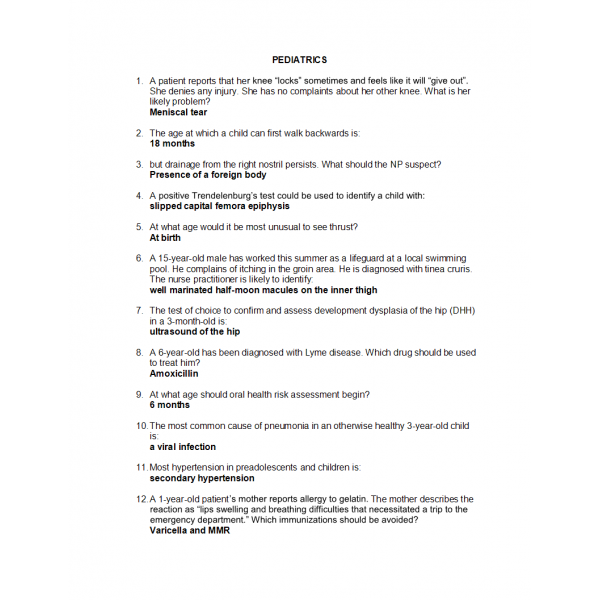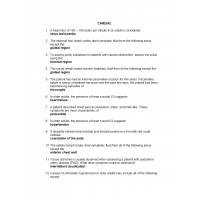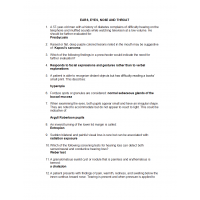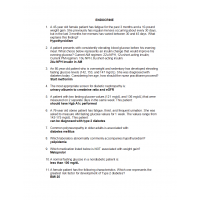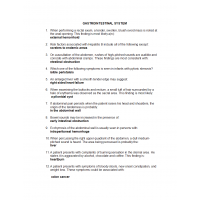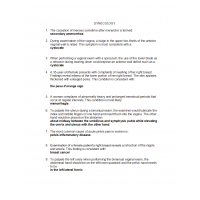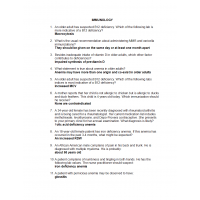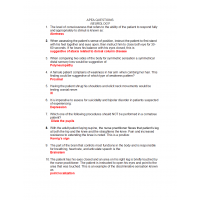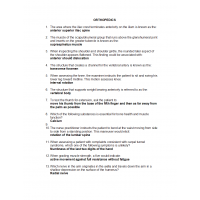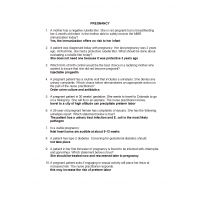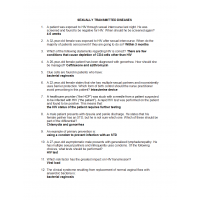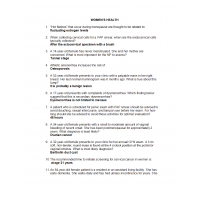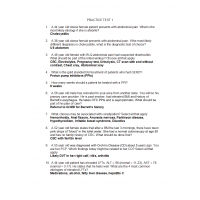NSG 6440 APEA Exam - PEDIATRICS
NSG 6440 APEA Exam - PEDIATRICS
1. A patient reports that her knee “locks” sometimes and feels like it will “give out”. She denies any injury. She has no complaints about her other knee. What is her likely problem?
2. The age at which a child can first walk backwards is:
3. but drainage from the right nostril persists. What should the NP suspect?
4. A positive Trendelenburg’s test could be used to identify a child with:
5. At what age would it be most unusual to see thrust?
6. A 15-year-old male has worked this summer as a lifeguard at a local swimming pool. He complains of itching in the groin area. He is diagnosed with tinea cruris. The nurse practitioner is likely to identify:
7. The test of choice to confirm and assess development dysplasia of the hip (DHH) in a 3-month-old is:
8. A 6-year-old has been diagnosed with Lyme disease. Which drug should be used to treat him?
9. At what age should oral health risk assessment begin?
10. The most common cause of pneumonia in an otherwise healthy 3-year-old child is:
11. Most hypertension in preadolescents and children is:
12. A 1-year-old patient’s mother reports allergy to gelatin. The mother describes the reaction as “lips swelling and breathing difficulties that necessitated a trip to the emergency department.” Which immunizations should be avoided?
13. According to the Tanner stages of development (Sexual Maturity Rating), breast development in Stage 5 in females includes the:
14. A young child has an audible murmur. The nurse practitioner describes it as a grade 4 murmur. How should this be managed?
15. At what age should initial blood pressure screening take place?
16. A 4-month-old is suspected of having developmental dysplasia of the hip (DDH). What test would best assess for this?
17. Hirschsprung’s disease is characterized by:
18. A young child has developed a circumferential lesion on her inner forearm. It is slightly raised, red and is pruritis. It is about 2.5 cm in diameter. This is probably related to:
19. An 8-year-old has a painful limp. He reports that his knee hurts medially. On exam he has pain with internal rotation of the hip. How should the NP manage this situation?
20. A mother presents with her 1-month-old infant. She reports that he cries inconsolably every evening after his first feeding. She asks for help. What should be done?
21. Children with an inguinal hernia:
22. A 6-year-old patient with sore throat has coryza, hoarseness, and diarrhea. What is the likely etiology?
23. Which of the following is true about metatarsus adductus?
24. What would be age appropriate anticipatory guidance for the parent of a 9-month-old infant?
25. A 7-year-old male presents with encopresis. The NP might expect:
26. A mother of a 4-week-old infant visits your office. She states that her baby is vomiting after feeding and then cries as if he is hungry again. What should the nurse practitioner assess?
27. A 4-year-old is being examined today in the NP clinic. He appears shy and does not make any eye contact with the examiner. The mother does not make eye contact with the examiner either. That patient lacks animation and does not smile. What likely possibility must be considered?
28. A pregnant patient is concerned because her 12-month-old needs an MMR immunization. What should the NP advise this patient?
29. A child with a sandpaper-textured rash probably has:
30. A 4-month-old infant has thrush. The mother is breast feeding. She reports that her nipples have become red, irritated and sensitive. What should the nurse practitioner advice the mother of this baby to treat thrush?
31. A child who can stack a maximum of five blocks is probably:
32. A pregnant mother in her first trimester has a 5-year-old who has Fifth Disease. What implication does this have for the mother?
33. Babies up to one year of age are called:
34. In a 3-year-old with fever, which occurrence might participate a febrile seizure?
35. Which of the following with decrease the risk of acute otitis media in a 6-month-old?
36. Epstein-Barr virus is responsible for:
37. A 12-month-old is here today to receive the varicella immunization. A patient’s mother reports that her 12-month-old child was exposed to chickenpox about a week ago. The NP should recommend that he:
38. A 5-year-old female’s playmate has been diagnosed with pinworms. The mother brings her child in for an exam. The 5-year-old denies rectal itching. How should the NP proceed?
39. An adolescent has acne. The nurse practitioner prescribed a benzoyl peroxide product for him. What important teaching point should be given to this adolescent regarding the benzoyl peroxide?
40. Which of the following increases the risk of cryptorchidism?
41. Which choice below is a risk factor for sudden infant death syndrome (SIDS)?
42. When is a child first able to stand on one foot?
43. A 4-year-old child with otitis media with effusion:
44. An infant is diagnosed with diaper dermatitis. Satellite lesions are visible. This should be treated with a:
45. Pharmacological treatment for children who have hypertension should be initiated for:
46. Which statement below is true of infants with development dysplasia of the hip?
47. A 6-week-old infant is found to have positive Barlow and Ortolani maneuvers. What test should the NP order to assess and confirm developmental dysplasia of the hip (DDH)?
48. A 3-day-old full-term infant has a bilirubin level of 16 mg/dL. How should this be managed?
49. A 10-year-old female presents with a 3 month history of abdominal pain. She has been diagnosed with recurrent abdominal pain. During the interview the nurse practitioner is likely to elicit a finding of:
50. Which reflex would NOT be expected in a 1-month-old?
51. What early finding may lead the provider to suspect renal artery stenosis in a 3-year-old male?
52. The nurse practitioner is examining a 3 month od who has normal development. She has identified an alopecic area at the occiput. What should be done?
53. An adolescent male has had a sudden onset of severe scrotal pain following a kick in the groin earlier in the day during a soccer game. How should this be managed?
54. Which patient below is most likely to experience stranger anxiety during a physical exam?
55. A 3-year-old had a fever of 102F for the last 3 days. Today she woke up from a nap and is afebrile. She has a maculopapular rash. Which statement is true?
56. A 12-year-old male with hip pain presents to the NP clinic. Hip pain has occurred with activity for the past 4-6 weeks, but his pain is worse and now involves the knee. This is no history of trauma. How should the workup be initiated?
57. A 2-month-old infant has an asymmetric Moro reflex. Which statement is true?
58. A 7-year-old boy who was previously unimmunized received his first tetanus, diphtheria, and acellular pertussis (TDaP), Hepatitis A, Hepatitis B, inactivated polio (IPV), measles, mumps, and rubella (MMR), and Varicella vaccinations one month ago. He returns today for his second series of immunizations. He should receive:
59. The term caput succedaneum refers to:
60. When does a child’s vision approximate 20/20?
61. A sexually active adolescent male reports that he has dysuria. How should this be managed?
62. A 2-year-old was brought into the clinic by her mother who reports that she pulled her arms upward to pick her up and now the child won’t use her right arm. A nursemaid’s elbow is suspected. Which statement below is correct?
63. A 2-year-old with sickle cell anemia (SCA) should receive which immunizations?
64. A 7-year-old enters the nurse practitioner clinic. There is no evidence that he received any immunization. What should be administered today?
65. A 9-year-old has been diagnosed with chickenpox. A drug should be avoided in him is:
66. What is the earliest age that an average child would appropriately receive construction paper and a pair of scissors with rounded points?
67. A mother reports that her child is not allergic to chickens but is allergic to ducks and duck feathers. The child is 4 years old today. Which immunizations should he receive?
68. The initial step in the management of encopresis is:
69. A 2-year-old has a sudden onset of high fever while at daycare. The day care attendant describes a seizure in the child. The child is brought to the clinic; neurologically he appears normal. His body temperature is 99.9F after receiving ibuprofen. He is diagnosed with otitis media. How should the nurse practitioner manage this?
70. A side effect of DTaP that should be reported is:
71. Head circumference should be measured until a child has attained:
72. What is the usual age for vision screening in young children?
73. A 6-year-old being treated for community-acquired pneumonia (CAP) has been taking azithromycin in therapeutic doses for 72 hours. His temperature has gone from 102F to 101F. What should be done?
74. The term that described the urethral opening on the ventral surface of the penis is:
75. The nurse practitioner sees a child who reports fatigue and presents with purpura on his lower extremities. His temperature is normal. The differential includes:
76. An otherwise healthy 6-year-old male has been diagnosed with otitis media. His mother reports that he has not had an ear infection since he was 3 years old. How long should he be treated with an antibiotic?
77. The patient presents with complaints of morning eyelash crusting and itchy red eyes. It began on the left and now has become bilateral. Based on the most likely diagnosis, what should the nurse practitioner tell the caregivers about this condition?
78. A 12-month-old was screened for iron deficiency anemia and found to be anemic. The nurse practitioner ordered oral iron. In 1 month, the child’s hemoglobin was reassessed. It increased greatly. Which answer might account for this?
79. A child received a burn on his chest from a cup of hot coffee. On examination, the injured area appeared moist, red to ivory white in color, and features blisters. It is painful to touch. This burn would be classified as a:
80. An NP examines a screaming 2-year-old. A common finding is:
81. Which infant feeding behavior is least likely related to congenital heart disease (CHD)?
82. A 6-month-old male has a palpable cystic mass in his scrotum. His mother states that sometimes the size of his scrotum varies. What should the nurse practitioner do next?
83. A 9-year-old female has presented to your clinic because of a rash on the left, upper area of her anterior trunk. She is embarrassed and very reticent to lift her blouse because her nipple will be exposed. How should the NP proceed?
84. According to the Tanner stages of development (Sexual Maturity Rating), breast development in Stage 3 in females includes the:
85. A tympanic membrane (TM) is erythematous. Which factor listed below is NOT the cause of an erythematous TM?
86. A 6-month-old child comes into the clinic for immunizations. Which item below allows a delay in his getting immunizations today?
87. The Sexual Maturity Rating (Tanner Staging) in boys includes 5 stages. Characterizes indicative of Stage 1 would include:
88. What is the earliest age that an average child would be able to copy a triangle, know his colors, and count on his fingers?
89. Medications considered first line to treat attention deficit disorder and attention deficit hyperactivity disorder are Schedule:
90. A healthy appearing 3-year-old female presents with nonblanchable redness over both knees and elbows. During the exam, she is found to have normal growth and development, and she interacts appropriately with the nurse practitioner. She had an upper respiratory infection about 4 weeks ago that cleared without incident. A CBC and urinalysis were obtained. The most likely diagnosis is:
91. A healthy 7-year-old child is diagnosed with atypical pneumonia. He is febrile but not in distress. What is the preferred treatment for him?
92. A 3-day-old infant weighed 8 pounds at birth. Today he weighs 7.5 pounds. How should this be managed?
93. The pneumococcal immunization in infants has:
94. When is Osgood-Schlatter disease most likely to produce symptoms?
95. A 6-year-old complains that his legs hurt. His mother states that he has been complained for the past 2 weeks, and she thought it was from “playing outside too much”. When asked to identify the painful areas, the child points to the midshaft of the femurs. He grimaces slightly when asked to walk. What should be part of the differential diagnosis?
96. A 3-year-old has fluid in the middle ear that does not appear infected. The eardrum appears normal. This is referred to as:
97. A 6-year-old who has moderate persistent asthma is diagnosed with pneumonia after chest x-ray and laboratory studies. He developed a sudden onset of fever with chills. He is in no distress. What is the preferred treatment for him?
98. A 15-year-old female has been sexually active since she was 12 years old. She presents today with concerns of pregnancy. How should this be managed?
99. A 1-week-old infant has a bilateral mucopurulent eye discharge. What explains the etiology of the discharge?
100. Hand foot and mouth disease and herpangina:
101. A 3-year-old has been diagnosed with acute otitis media. She is penicillin allergic (Type 1 hypersensitivity reaction). How should she be managed?
102. What advice should be given to a parent who has a child with Fifth Disease?
103. A child has 8-10 medium brown café au lait spots > 1 cm in diameter. The differential diagnosis should include:
104. Risk assessment for dyslipidemia should begin at:
105. An 18-month-old child is diagnosed with bronchiolitis. His respiratory rate is 28 breaths per minute. Which choice below is most appropriate for patient management?
106. A contraindication to giving MMR vaccination is:
107. Many factors can contribute to the risk of congenital heart disease. Which maternal disease carries a higher risk of transposition of the great vessels (TGA), ventricular septal defect (VSD), and hypertrophic cardiomyopathy?
108. What Tanner stage corresponds to an average 8-year-old male?
109. A 4-year-old was diagnosed and treated for acute otitis media in the left ear 4 weeks ago. She is here today for a well-child visit. There is an effusion in the left ear. She denies complaints. How should this be managed?
110. An adolescent takes isotretinoin for nodulocystic acne. She is on oral contraceptives. Both were prescribed by the dermatologist. The adolescent presents to your clinic with a sinus infection. Her temperature is 99.5F and her blood pressure is 160/100 mmHg. How should this be managed?
111. How often should blood pressure be measured in a child who is 3 years old?
112. An infant is brought to the nurse practitioner because his gaze is asymmetrical. Which finding indicates a need for referral to ophthalmology?
113. A 7-year-old has a complaint of ear pain. If he has otitis externa, which complaint is most likely?
114. A child’s resting heart rate is expected to be between 60 to 100 beats per minute once he reaches:
115. The first sign that a male child is experiencing sexual maturation is: increase in testicular size
116. The nurse practitioner identifies satellite lesions in a 6-month-old infant. These are:
117. Which of the following is an appropriate initial intervention for gastroesophageal reflux disease (GERD) in an 8-week-old?
118. Clubfoot: involves the foot and lower extremity
119. A 14-year-old male patient has an acute, painless groin swelling. Which tool would yield the most information to identify the etiology of the swelling?
120. An adolescent complains of knee pain. He is diagnosed with Osgood-Schlatter disease. What assessment finding is typical?
121. The average age of pubertal growth spurt in North American boys is:
122. A 6-month-old infant has a disconjugate gaze. The nurse practitioner observes that the 6-month-old tilts his head when looking at objects in the room. Which statement is true?
123. A 6-year-old is brought to your clinic because of behavior problems at school. DSM V criteria are used to diagnose attention deficit disorder (ADD). Which finding is likely present?
124. A 6-day-old has bilateral mucopurulent eye discharge. Which historical finding explains the etiology of the discharge?
125. A patient has suspected scarlet fever. He likely has a sandpaper rash and:
126. A 2-month-old is diagnosed with thrush. An exam of this patient’s saliva demonstrates all except:
127. A male child has swelling in the upper left thigh below the inguinal ligament. He complains of cramping and intermittent lower abdominal pain. What should be included in the differential diagnosis?
128. The chest circumference of a 12-month-old is:
129. A 4-year-old has been diagnosed with measles. The nurse practitioner identifies Koplik’s spots. These are:
130. When can a child with chickenpox return to daycare?
131. A congenital heart abnormality often discovered during the newborn period is coarctation of the aorta. How is this assessed?
132. Which statement about attention deficit disorder (ADD) is correct?
| Institution & Term/Date | |
| Term/Date | South University |
-
$30.00

